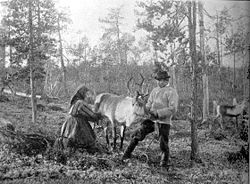| Discipline | Reindeer husbandry |
|---|---|
| Language | English |
| Edited by | Birgitta Åhman |
| Publication details | |
| History | 1981–present |
| Publisher | Nordic Council for Reindeer Husbandry Research Swedish University of Agricultural Sciences (Sweden [1] ) |
| Frequency | annual |
| Yes | |
| License | Creative Commons Attribution 3.0 |
| Standard abbreviations | |
| ISO 4 | Rangifer |
| Indexing | |
| ISSN | 0333-256X (print) 1890-6729 (web) |
| Links | |

Rangifer is an open-access scientific journal about northern ungulates and reindeer husbandry.
Contents
Rangifer is published since 1981 by the Nordic Council for Reindeer Husbandry Research. [2] Paperback Rangifer was published regularly from 1981 to 2007. [2] It was published by the Nordic Council for Reindeer Husbandry Research at the Swedish University of Agricultural Sciences, in the Department of Animal Husbandry and Management in Uppsala, Sweden. [1] Special and report issues started at volume 28, 2008. [2] Since then, it is primarily an online journal. [3]
Rangifer publishes original research papers, review articles, and brief communications in all themes and fields related to reindeer and reindeer husbandry as culture and industry, including papers on other northern ungulates. [3] The contents have "mainly been non-peer-reviewed material." [1] The journal publishes under a Creative Commons Attribution (CC-BY) licence. [3]
The journal is indexed and abstracted in BIOSIS, Biological Abstracts, CAB International and AGRIS. [2]